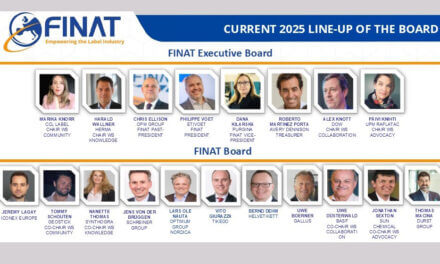PRINTING BOARD Analyse user needs from a new slant and increase ones own turnover exploiting the characteristics of inkjet digital printing. Analyses and proposals by Durst that at Grafitalia presented their latest, innovatory machine dedicated to converting.
Durst Phototechnik SpA (inkjet print systems for industrial applications, Bressanone/Brixen, BZ) closed last year with the best balance of its history (+12%) after an already brilliant 2011 (+14%), and this year charges on at great speed with new goals on the horizon. This growth is aboveall powered by a strong commitment to R&D, recently made manifest in the proposal of new converting and graphic printing systems, popular with the market and also a great success at the last Grafitalia (where a series of contracts were signed “live” at the fair).
During the event Durst’s sales head for Italy Alberto Bassanello explained why. «Periods of crisis are the best times for presenting revolutionary technology, because they enable you to offer users original ideas for creating products with greater added value». The proceedings in different segments, though with features typical to industry in times of crisis, allow one to understand what this actually means.

«The Italian tile sector in just a few years nose-dived from 600 to 300 million sqm but, despite this debacle it constitutes an important outlet for Durst’s technology (alongside print graphics, converting, labeling, textiles and glass, Ed.). In ceramics indeed the manufacturers who have been able to exploit the advantages of digital decoration in terms of both creativity and cost are currently reaping the benefits (Durst has just celebrated the hundredth installation in this area of application, Ed.). Our machines allow them to achieve all the graphics and the decorations the marketing department is capable of thinking up in record time, while providing customized products just in time, dramatically reducing delivery times and, aboveall, drastically reducing costs, also and aboveall on small lots. Thus Italian producers have been able to conform to the new market rules while levering on the flair and expertise of Italian products, a real added value, very much appreciated the world over. And indeed it’s the same story in the other segments, because the demands are the same wherever you are: users want flexibility, speed, innovation and, aboveall efficiency in terms of costs. Digital printing offers all this».
And converting? It needs to gain momentum. In publishing, commercial printing and to some degree in converting and packaging products the story is much the same. Durst presides over all these sectors, with a range of machines designed to suit the characteristics of each application, of which the Rho P10 PAC, previewed at Grafitalia 2013, is the latest creation. The interest it aroused at the fair, in the analyses of Durst’s marketers, is born out of the fact that, as has already occurred in time in the service of digital printing, the converting concerns and casemakers are now concentrating on strengthening their services and on rationalising production costs and processes.
It is a change of mentality that, in terms of equipment, demands evermore flexible machines. «A striking example – Bassanello goes on to explain – is offered by the use our customers make of our Rho 500Rs, that have a web width of 5 metres. Created for wide formats, thanks to a high print quality they enable the highly accurate reproduction of poster graphics the same as the details of a label. As well as that, thanks to the versatility of the digital setting they are used for the printing on several reels of material and products of varying sizes placed together».
Rho P10 in PAC version offers the same flexibility for printing both flat and corrugated cardboard. «This machine – Bassanello states – guarantees a quality comparable to offset, a productivity of up to 205 sqm/h and it processes all types of material up to 205 cm wide for the length required. Having been thought up for converting concerns, it includes automatisms enabling working on three shifts without additional costs in manpower: automatic feeder&stacker with compensatory loading/unloading, empowered suction a surface and guide system that ensures flatness of material in the print phase all contribute to achieving the results».
Its heart comprises the Durst UV Quadro Array inkjet heads, mounted on all the Rho P10s, that enable printing with resolutions up to 1000 dpi and the option of additional light colors and white, also offering “hi fidelity” reproduction of nuances and the smallest details. This presentation, the company technicians explain, is attained thanks to the innovatory Variodrop technology, that emits drops that are practically invisible, achieving homogenous prints without the “dotty” effect on all types of board, even corrugate, while improving productivity by as much as 25%. «The market response has been highly positive: a year from the launch at Drupa 2012, in Italy we have installed thirty or so Durst Rho P10s, 6 of which in the PAC version. And this is only the start of things».
Web service? A trail blazer
The print services, and in particular those that operate via the web, were among the first to grasp the potential of digital, due to the fact that providing quality, competitively priced products at utmost speed lies in their very reason for being. Bassanello quotes a famous testimonial: «After carefully analyzing the market, Pixartprinting chose our Rho P10 10 pircolitre UV inkjet printer, for three basic reasons: the completeness of the machine in terms of material in- and outfeed, the considerably increases productivity; the print quality, all the more indispensable in that a web to print service does not have direct contact with the customer and hence the product is the “face” of the same; a complete, immediate technical assistance. Durst is capable of guaranteeing the same because we are direct producers of all the machine components – mechanics, electronics and software – and hence we can intervene on the spur of the moment regarding any operational feature».
















